The Americans entered the European theater with their mind set firmly on daylight bombing. This was something the British had tried and given up due to the high level of casualties in both men and machines. The Americans now were facing the very same problem in 1943. The German flak and fighter cover had taken a heavy toll on unescorted bombers.
The mission to Schweinfurt and Regensburg cost the USAAF 60 bombers and this was a disaster that could not be often afforded. The outcome in part was a raging debate in the American Congress as they tried to decide if daylight bombing should continue.

A recurring problem for daylight bombing
The debate and bad weather over Europe temporarily halted bomber operations and gave the Germans a much-needed respite. The Americans came to the conclusion that bombers alone could not survive in the hostile skies. This same situation had the British switching to night operations.
The Americans respected the British choice and courage that they displayed on their night missions, but they firmly held to the belief that for the USAAF daylight precision bombing was needed. In many ways, it was a good plan. With the Americans bombing by day and the British by night, it gave the Germans no break and was a drain on their resources.
The problem the Americans faced was obvious; bombers lacked the ability to adequately protect themselves against determined enemy attacks. The answer was very difficult. It rested on bomber escort fighters, but the targets were in most cases well out of range of Allied fighters. This left the bombers with no choice but to fly unescorted missions.
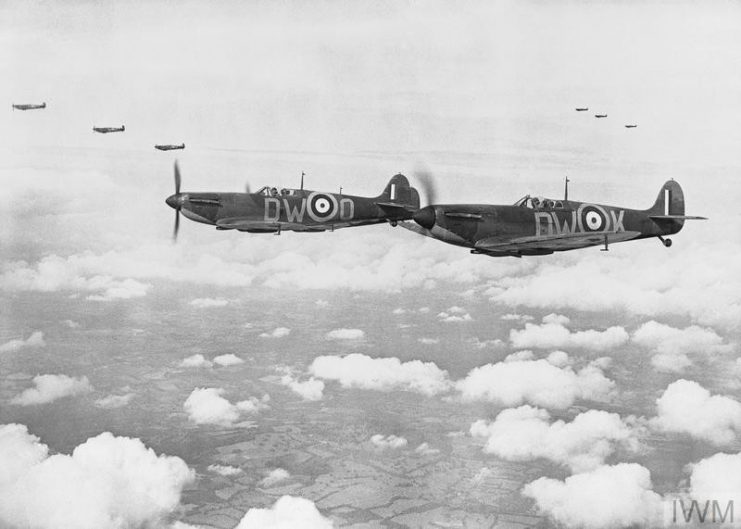
The RAF was more than willing to offer help, but the Spitfires could only fly as far as Paris and this was well short of the range required. They certainly did give a morale boost to returning B-17s. These bombers were often damaged and carrying dead or wounded crew. Yet having a Spitfire come up on their wing gave them the sense that home wasn’t far away and that they were not alone. The Spitfires acted as a deterrent to attacking Luftwaffe on the way back over the channel.
Long range bomber escort
The solution had to be found in a long-rang fighter. Initially, the P-38 Lightning was allocated to the 8th AAF, but this didn’t last long as the fighters were needed for the North African Campaign. The USAAF settled on the P-47 Thunderbolt. This huge fighter could travel as far as the German border and was a great boost to the bombers, but it still meant that they would be alone for any mission within Germany.
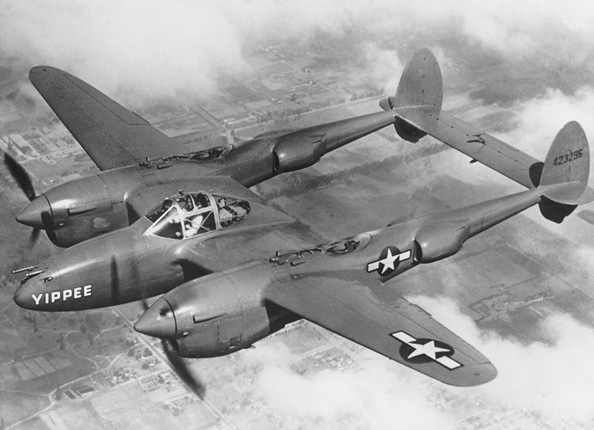
The P-38s, however, were able to reach Berlin and there was a great deal of hope that the Lightnings would arrive in strength. The P-38s did not do well in the European climate and they suffered terribly with many reliability issues. In the end, something else was needed.
Birth of a Mustang
The P-51 was not originally conceived as an outstanding fighter. The British placed an initial order, but like the USAAF they did not seem overly excited about the design. No one really knew that they had a great plane in the making. The P-51 was fitted with the Allison V-1710 engine, which was a good engine in its own right, but its development had been slow. The Allison engine also performed very badly at the altitudes that bomber escort missions were required to operate at.
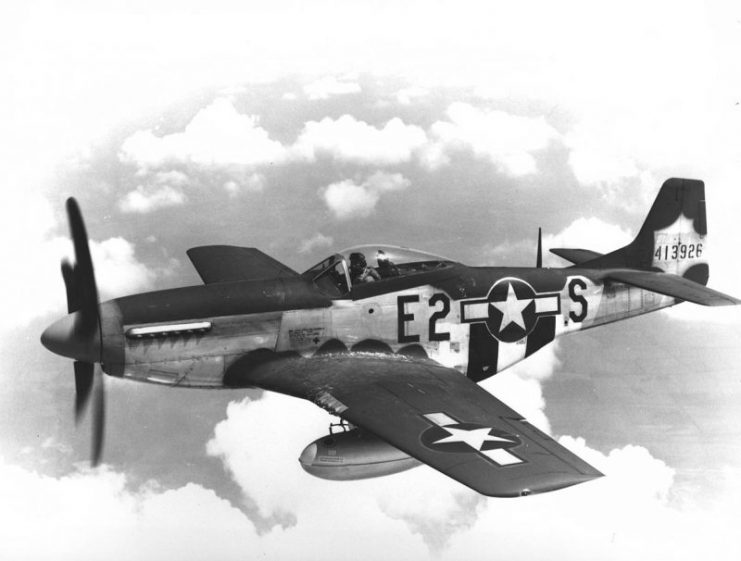
The idea of putting a British engine in an American design was rather unpopular and it created a great deal of political wrangling which delayed the project. The first P-51b was finished in June 1943. In it was now fitted the Rolls Royce Merlin engine, which produced a staggering 600hp more than the Allison engine.
The Allison equipped Mustangs had been doing a decent job at ground attack and the USAAF was still keeping to that idea. The 354th was the first American unit to receive the new P-51s. There was a great deal of negotiating taking place and in the end, the 8th AAF had the 354th transferred to them. They, in turn, gave the 9th AAF the 358th FG which was flying the P-47 Thunderbolts. The P-47 was an extremely good aircraft for ground attack and both parties were happy with the trade.
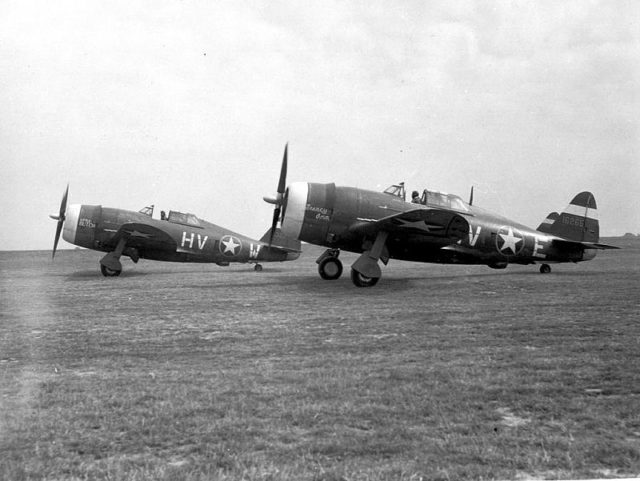
Col Kenneth Martin commanding the 354th did not have much time for his men to get additional training. One situation that was hampering his efforts was that the Mustang was also suffering some acclimatization problems with its new engine, much as the P-38s had done.
The ground crews were working long hours to get everything sorted out. One major problem the P-51 suffered from was gun jams. The narrow wings did not leave much room to fit weapons and ammunition. This lead to a complex ammunition feed system which could freeze in the sub-zero temperatures at high altitude.
Demand for the new fighter was high and the 4th FG was trying hard to get it. They had previously flown Spitfires and the P-51 seemed similar in many ways. They were flying the massive P-47 Thunderbolts and the pilots had never really taken to the plane. They waited with barely contained eagerness.

The weather over Europe was an ongoing problem and this created unexpected problems. The weather could change significantly during the course of a mission and there were occasions when the rendezvous points became obscured. The fighter escort may not run into the bombers they were meant to protect. Slowly, the 8th began the difficult process of re-equipping their fighter squadrons.
Yet the tide was about to turn. The Mustang was coming to Europe.
Escort Missions and Concepts
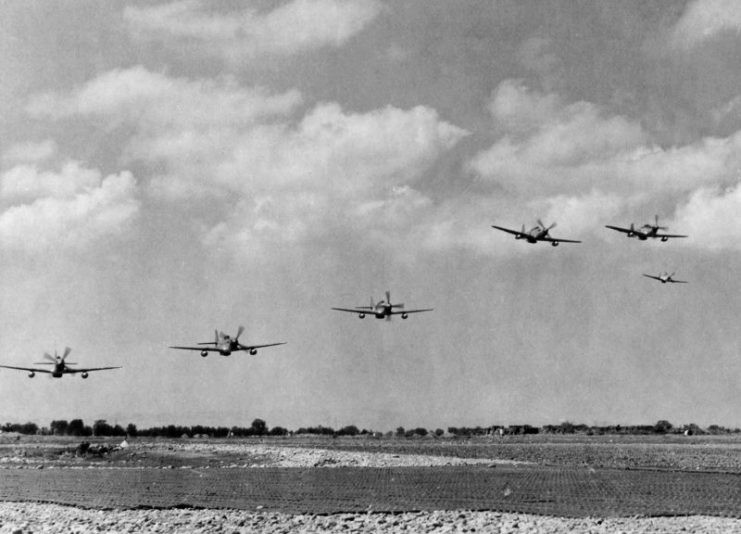
The 8th policy of hunting the Luftwaffe wherever it made its home was having a detrimental effect upon Luftwaffe operations. It was also taking a toll on the 8th as ground attack missions, especially on airfields, were dangerous and fatiguing work.
Bomber Escorts
The Mustangs would return to bomber escort on the 13th April 1944. The target was Berlin and it was never popular with the crews. It proved to be a costly day. George Carpenter, an ace with 13 kills, was shot down and captured, along with Lloyd Henry who was captured, and Vic France, who was killed when he crashed into the ground during a low-level dogfight.
The 19th of April saw a large dogfight develop while escorting bombers. By its end, 16 German fighters had been shot down, though Capt Charles Anderson was lost. It appeared that he was also hit by the B-17s that he was escorting which took him to be an enemy fighter.

The German heavy twin-engine fighters were excellent bomber destroyers, but very vulnerable to single engine Allied fighters. The 24th of April saw both the 355th and 375th FG claiming 42 enemy aircraft which included a fair number of the twin-engine types. One problem with these large engagements was they tended to end at low altitudes. This would leave the bombers undefended during that time.
The Mustang was a great plane and its pilots were well trained, but for a mission to be successful, there were multiple aspects which had to come together. Possibly the most important was for the bombers to create a tight defensive formation. This allowed solid defensive fire but also took up less airspace and was therefore easier for the fighters to guard.
If the assembly failed and the bombers become spaced too far apart, then it would be all that much harder to defend from the talented German aces who could exploit the cracks in the formation’s armor.
When this happened on April 29th, 1944, during a raid on Berlin, it allowed the German fighters and air defenses to take a heavy toll on Allied bombers. A total of 55 bombers were lost in one of the worst days of the entire bombing campaign. In return, the escorts only claimed 14 enemy fighters.
Denying the enemy its airspace

With D-Day approaching some of the fighter groups started to move towards engaging in tactical targets more than in the past. The Luftwaffe did not waste itself on fighter intercept missions and preferred to show only when the Allies conducted bombing operations. The Luftwaffe was having trouble replacing pilots and this was a situation that was only going to worsen.
Pilots were getting to the front with less training and it was showing. Days like the 13th of May saw one Luftwaffe unit lose nine aircraft to the 355th and the 357th, which tore into the twin-engine fighters.
Denying the enemy logistical support for the D-Day invasion was becoming ever more important. Railway rolling stock and locomotives especially became full-time targets for some fighter groups in what was known as Chattanooga Strikes.

For the bombers, their focus turned to oil, the importance of which was not lost on the Germans, and their facilities were some of the most heavily defended. Heavy fighting took place on the 29th of May during an attack on Politz.
The escorts held the defensive line well under repeated attack from the Luftwaffe and finished with 12 enemy planes shot down. The following day saw a further 17 enemy planes destroyed. However, the 8th lost Fletcher Adams, an ace with nine kills when his flight was bounced out of the sun by BF-109Gs.
The P-51 was now making its mark felt. They were disrupting Luftwaffe operations on the ground and in the air. The Germans were losing control of the air.
P-51 Mustang at D-Day
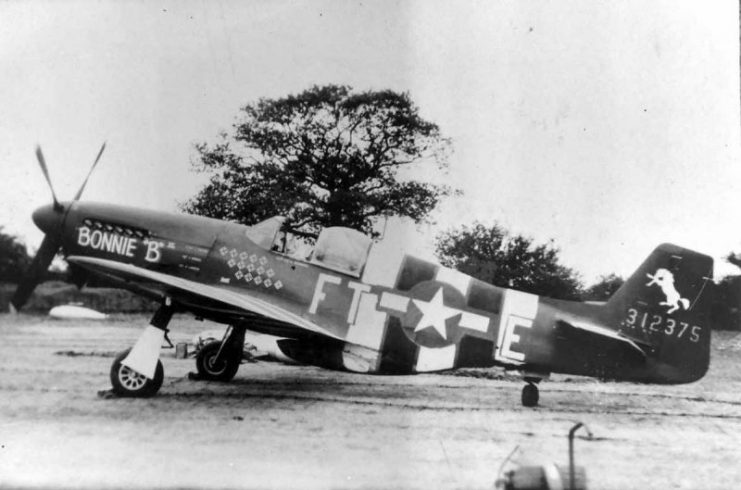
The Allies amassed a formidable force in preparation for D-Day, the Allied landings at Normandy on June 6th, 1944. They concentrated on enemy airfields and logistics, with particular attention given to any transport elements like railway stock and locomotives that could be used to move troops to the beaches.
Between the Commonwealth, pilots from the occupied nations, and the Americans they did their best to make the French coast a very unsafe place to be for the enemy.

Mustangs during D-Day
For D-Day, a solid air cover was required as there was no telling how strong the Luftwaffe’s response would be. For the first patrols, the twin-engine P-38 Lightning was selected. The Lightning was a radical design that had a very unique shape and it was thought that this would lower the chance of friendly fire incidents.
For the aircraft involved in the invasion, they would feature a series of black and white stripes on the rear fuselage and also on the underwing surfaces. These could be seen from the ground and help to identify the aircraft as a friendly.
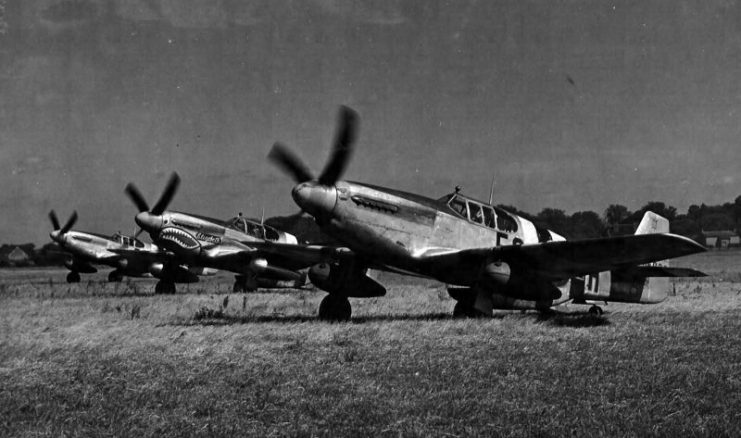
For most of the day, the Luftwaffe did not launch any attacks. A massive intelligence operation had been in effect to try and convince the Germans that the real landing would take place in the Pas De Calais and not Normandy.
This created considerable confusion on the day of the invasion as the Germans were not sure if it was a diversion. The Germans held back their tanks and Luftwaffe just in case and crucial time was lost.
Wanting to play their part, it caused a great deal of anguish amongst the Allied pilots when they learned of the horrible conditions and casualties being inflicted on the beaches of Normandy and knowing that they really could, at that stage, do little to help.
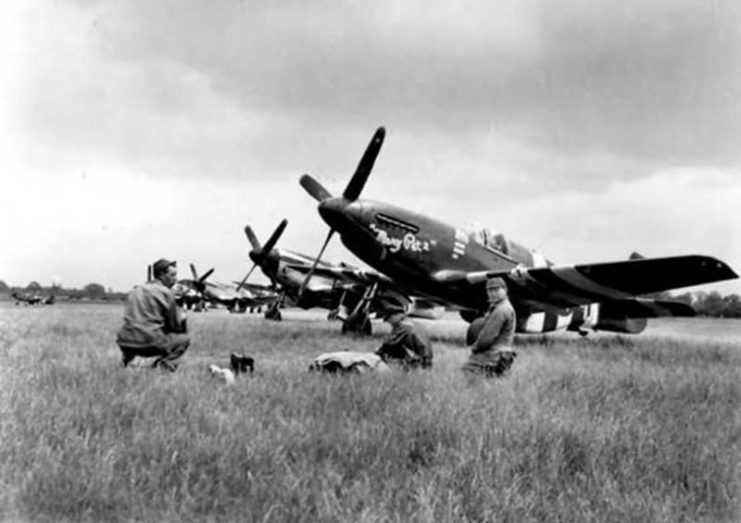
It was late in the day when the Luftwaffe finally attacked, all be it in limited strength. An Fw-190 was shot down by the 4th FG and 17 JU-87 Stuka dive bombers were shot down in various engagements by the 355th, 357th, and 339th. The Stukas were outclassed back in 1940 and were even less of a match for the 8th Mustangs.
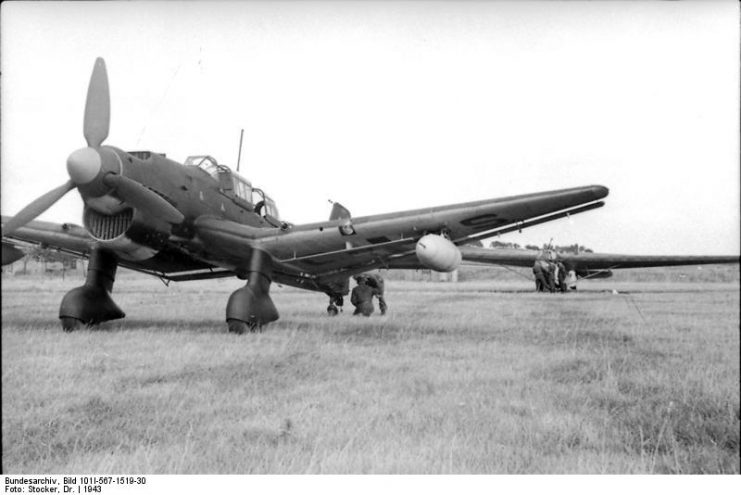
By this period of the war, the Luftwaffe had been severely weakened. There were still some incredible Aces flying, but it was no longer the power it had been in 1940. The war being fought on multiple fronts had lost them some of their most experienced crew and training time had been reduced.
Once it was realized that Normandy was the invasion point the Luftwaffe became more active. Units were moved forward and their presence was seen to increase. By the end of the 8th of June, however, they had lost 31 aircraft. 11 of these was to one 8th Air Force Fighter Squadron alone.
D Model Mustangs

By now the 8th AAF was starting to receive the D model Mustang. To many people, this is the iconic Mustang. Possibly the most important improvement was a redesigned fuselage, which allowed a bubble canopy to be fitted.
This new canopy, which was largely free of a metal frame, gave the pilot fantastic visibility. A new gyro gun sight was also fitted. This complex sight helped with the difficult art of deflection shooting and was a welcome addition to the fighter.
Bomber escort missions were still handled for the most part by the P-51 Mustangs, yet the German army was fighting back hard and there was an ever-increasing call for ground attack and close air support missions.
